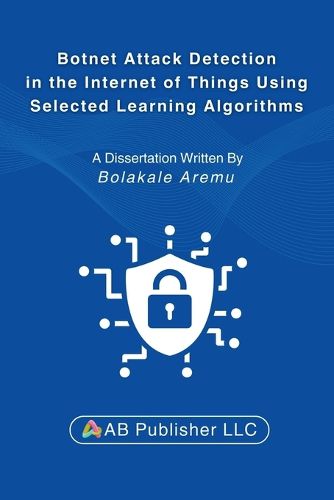Readings Newsletter
Become a Readings Member to make your shopping experience even easier.
Sign in or sign up for free!
You’re not far away from qualifying for FREE standard shipping within Australia
You’ve qualified for FREE standard shipping within Australia
The cart is loading…






This title is printed to order. This book may have been self-published. If so, we cannot guarantee the quality of the content. In the main most books will have gone through the editing process however some may not. We therefore suggest that you be aware of this before ordering this book. If in doubt check either the author or publisher’s details as we are unable to accept any returns unless they are faulty. Please contact us if you have any questions.
A Must-Read for IoT Security Researchers and Machine Learning Experts
As IoT networks continue to expand, so do the complexities of securing them against botnet attacks. The diversity of devices, varying computational capabilities, and different communication protocols make developing a universal botnet detection system a significant research challenge. This book provides a rigorous, data-driven approach to tackling this issue using supervised machine learning algorithms.
Based on the NB-IoT-23 dataset, this research evaluates multiple classification techniques, including Logistic Regression, Linear Regression, Artificial Neural Networks (ANN), K-Nearest Neighbors (KNN), and Bagging. The findings reveal that the Bagging ensemble model outperforms others, achieving an exceptional 99.96% accuracy with minimal computational overhead, making it a strong candidate for real-world IoT botnet detection systems.
Key Features for Academic Researchers:
Comprehensive IoT Security Analysis - Explore the unique challenges of botnet detection across diverse IoT devices. Advanced Machine Learning Techniques - Compare different learning algorithms and their effectiveness in botnet detection. High-Quality Dataset & Empirical Evaluation - Gain insights from real-world NB-IoT-23 datasets featuring data from multiple IoT devices. Research-Backed Findings - The book presents reproducible results, making it a valuable reference for Master's and Ph.D. students exploring IoT security, cybersecurity, and machine learning. Future Research Directions - Identify gaps and opportunities for further exploration in IoT security and anomaly detection.
This book serves as a practical and theoretical resource for graduate students, cybersecurity professionals, and researchers interested in IoT security, network intrusion detection, and applied machine learning.
Enhance your research and contribute to securing IoT networks-get your copy today!
$9.00 standard shipping within Australia
FREE standard shipping within Australia for orders over $100.00
Express & International shipping calculated at checkout
Stock availability can be subject to change without notice. We recommend calling the shop or contacting our online team to check availability of low stock items. Please see our Shopping Online page for more details.
This title is printed to order. This book may have been self-published. If so, we cannot guarantee the quality of the content. In the main most books will have gone through the editing process however some may not. We therefore suggest that you be aware of this before ordering this book. If in doubt check either the author or publisher’s details as we are unable to accept any returns unless they are faulty. Please contact us if you have any questions.
A Must-Read for IoT Security Researchers and Machine Learning Experts
As IoT networks continue to expand, so do the complexities of securing them against botnet attacks. The diversity of devices, varying computational capabilities, and different communication protocols make developing a universal botnet detection system a significant research challenge. This book provides a rigorous, data-driven approach to tackling this issue using supervised machine learning algorithms.
Based on the NB-IoT-23 dataset, this research evaluates multiple classification techniques, including Logistic Regression, Linear Regression, Artificial Neural Networks (ANN), K-Nearest Neighbors (KNN), and Bagging. The findings reveal that the Bagging ensemble model outperforms others, achieving an exceptional 99.96% accuracy with minimal computational overhead, making it a strong candidate for real-world IoT botnet detection systems.
Key Features for Academic Researchers:
Comprehensive IoT Security Analysis - Explore the unique challenges of botnet detection across diverse IoT devices. Advanced Machine Learning Techniques - Compare different learning algorithms and their effectiveness in botnet detection. High-Quality Dataset & Empirical Evaluation - Gain insights from real-world NB-IoT-23 datasets featuring data from multiple IoT devices. Research-Backed Findings - The book presents reproducible results, making it a valuable reference for Master's and Ph.D. students exploring IoT security, cybersecurity, and machine learning. Future Research Directions - Identify gaps and opportunities for further exploration in IoT security and anomaly detection.
This book serves as a practical and theoretical resource for graduate students, cybersecurity professionals, and researchers interested in IoT security, network intrusion detection, and applied machine learning.
Enhance your research and contribute to securing IoT networks-get your copy today!